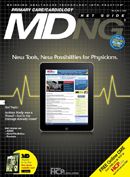Publication
Article
MDNG Primary Care
Atrial Fibrillation
Online CME
Management of Atrial Fibrillation
Credits: 2.00
Fee: $40.00
Expires: June 14, 2011
Multimedia: Audio/Video
Harvard Medical School offers this course, which covers “key topics in the diagnosis and evidence-based management of common atrial arrhythmias.” Course content covers the clinical and electrocardiographic evaluation of these arrhythmias; medical management, including the use of and special considerations in antiarrhythmic drug therapy; assessment of thromboembolic risk and anticoagulation; and contemporary invasive strategies.
Novel Oral Antithrombotic Therapies for Patients with Atrial Fibrillation
Credits: 2.50
Fee: None
Expires: October 12, 2011
Multimedia: Audio/Video
The disadvantages of use of warfarin for stroke prevention in patients with AFib and novel strategies for stroke prevention in patients with AFib, including the use of aspirin and low dose warfarin, are among the topics covered in this activity, which will also identify new oral anticoagulant agents and describe their potential for use in patients with AFib for prevention of stroke.
Atrial Fibrillation in Focus: Optimizing Patient Outcomes through Evidence-Based Practice
Minimizing the Burden and Costs of Stroke in Patients with Atrial Fibrillation
http://www.naccme.com/program/2010-393-2/
Implementation of Current Guidelines and New Concepts in the Management of Atrial Fibrillation
65-Year-old Man with Hypertension and LVH
72-Year-old Man with AFib and Heart Failure
72-Year-old Woman with Paroxysmal AFib
Clinical Trials
AFib Patients with Planned Anticoagulant Therapy
AFibAblation Device Comparison Study
AFib/Flutter Outcome Risk Determination
The Dynamics of Human AFib
Esophageal Injury after Catheter Ablation for AFib
The Genetic Basis of AFib
Investigational Blood Thinner to Prevent Clots in AFib Patients
Yoga on Arrhythmia Burden and Quality of Life in Paroxysmal AFib
Medical Websites
Update on the Management of Patients with Atrial Fibrillation
Bookmark this site, which features the most recent practice guidelines on the management of patients with atrial fibrillation, as developed by the American College of Cardiology Foundation and the American Heart Association. Published in Circulation in 2010, the article “focuses on several areas in which new data on management of patients with atrial fibrillation (AFib) have become available, including a) recommendations for strict versus lenient heart rate control, b) combined use of antiplatelet and anticoagulant therapy, and c) use of dronedarone.” Among the topics covered are: rate control during AFib, recommendations for combining anticoagulant with antiplatelet therapy, emerging and investigational antithrombotic agents, nonpharmacologic approaches to prevention of thromboembolism, recommendations for dronedarone for the prevention of recurrent AFIB, and recommendations for maintenance of sinus rhythm.
From the Literature
The Link between Diabetes and AFib
Although the association between atrial fibrillation and diabetes mellitus (DM) has been confirmed both in epidemiological and experimental studies, the causal links need to be verified in a large cohort study. Further research on the impact of DM on the incidence, recurrence, and progression of AFib is needed.
Predicting Thromboembolic Events in Patients with AFib
Elevated B-type natriuretic peptide levels can potentially be a useful marker of subsequent thromboembolic events in patients with atrial fibrillation during oral anticoagulant therapy.
Risk Factors for AFib Following Coronary Artery Bypass Surgery
Advanced age, hypertension, diabetes, obesity, hypercholesterolemia, leukocytosis, and segmental kinetic disturbances of the left ventricle are powerful risk factors for the occurrence of postoperative AFib following coronary artery bypass surgery.
Surgical Ablation Is a Safe, Effective Alternative
In patients with low ejection fraction and symptoms of heart failure experiencing AFib, surgical ablation can be performed in a safe and effective way without added operative risk. Given the potential long-term clinical advantages, researchers believe that surgical ablation should be considered in these patients when they present to surgery.
Using Automated Pharmacy Data to Study Warfarin Use
A study found that an automated pharmacy database proved to be a valuable source of data for pharmacoepidemiologic research on warfarin use among patients with AFib.
Warfarin Use in Systolic Heart Failure Patients without AFib
In patients with chronic advanced systolic heart failure without AFib, previous thromboembolic events, or prosthetic valves, prevalence of warfarin use was high. However, despite a therapeutic international normalized ratio in those receiving warfarin, its use was not linked with mortality and hospitalization.
The Educated Patient
StopAFibib.org
Part of the American Foundation for Women's Health, StopAFibib.org was developed to increase patients’ knowledge about atrial fibrillation, a “progressive and debilitating disease” that is characterized by heart palpitations, dizziness, and shortness of breath, and “can lead to stroke, heart failure, and Alzheimer's disease.” Here, patients can learn what the condition feels like, how it can impact quality of life, and how to manage it, while also obtaining information on the risk factors, triggers, and symptoms of the disease, conditions that can result from AFib, categories of AFib, and how it is diagnosed. Visitors can also read patient stories, keep up on the latest AFib news, and access patient and caregivers resources.
A Patient’s Guide to Living with Atrial Fibrillation
Published in 2008 in Circulation, this Cardiology Patient Page provides important information about AFib, a condition that affects approximately 4% of adults over 65 years of age. Targeted toward fairly well-educated patients, the article outlines the symptoms and risk factors associated with AFib; discusses the use of anticoagulation; identifies different treatment methods for AFib, including heart rate control, heart rhythm control, electrical cardioversion, and catheter ablation; and outlines lifestyle adjustments that can be made by those with AFib, as well as coping strategies.
What Is Atrial Fibrillation?
Along with the standard information on the symptoms, risk factors, and treatment of AFIB, this offering from the National Heart Lung and Blood Institute features a video that “shows how the heart's electrical signal begins in a place other than the sinoatrial node, causing the atria to beat very fast and irregularly.” Visitors can also learn what to expect during a physician visit, and how to prevent AFIB (the site includes a link to more information on the DASH diet).
